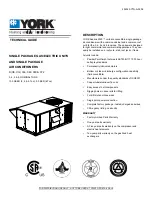
10
GB
D
F
E
I
NL
P
GR
RU
TR
CZ
SV
HG
PO
9. Duct work
•
Use the recommended data to design the installation, so as to achieve best
silent performance.
•
Use non-combustible duct components.
•
Install sufficient thermal insulation to prevent condensation forming on outlet
duct flanges and outlet ducts.
Caution:
•
The noise from the intake will increase dramatically if intake
A
A
A
A
A
is fitted
directly beneath the main body. Intake
A
A
A
A
A
should therefore be installed as
far away from the main body as possible.
Particular care is required when using it with bottom inlet specifications.
•
To connect the air conditioner main body and the duct for potential equali-
zation.
[Fig. 9.0.1] (P.3)
A
Air inlet
B
Air outlet
C
Access door
D
Ceiling surface
E
Duct
F
Duct box
G
Air filter
H
Inlet grille
Caution for dew condensation-proof ducting
1. Use glass-wool duct (aluminum surface) as outlet duct in the field.
2. If use aluminum tape to fix the connection, be sure to proceed dew condensa-
tion prevention above the tape.
3. There is possibility of dew condensation on the surface of aluminum tape or
glass-wool duct, which may develop to water-drop.
4. Dew condensation proof material recommendation: Polyethylene foam or
equivalent.
•
Thickness:
=
5mm: Wideness:
=
150mm
•
Isolated foamed (non-water-absorbing)
•
Heat conductivity:
=
0.032 W/(m·K)
The material should be applied to the duct around the outlet connection as shown
below.
[Fig. 9.0.2] (P.3)
A
Aluminum tape
B
Glass-wool duct
C
Dew condensation proof material
D
Indoor unit body
Type of cable
Transmission cables
Shielding wire (2-core)
CVVS, CPEVS or MVVS
More than 1.25 mm
2
ME Remote controller cables
0.3 ~ 1.25 mm
2
(0.75 ~ 1.25 mm
2
)*1
MA Remote controller cables
0.3 ~ 1.25 mm
2
(0.75 ~ 1.25 mm
2
)*1
Cable diameter
Remarks
Sheathed 2-core cable (unshielded) CVV
10.1. Power supply wiring
•
Use dedicated power supplies for the indoor unit.
•
Bear in mind ambient conditions (ambient temperature, direct sunlight, rain
water, etc.) when proceeding with the wiring and connections.
•
The wire size is the minimum value for metal conduit wiring. If the voltage
drops, use a wire that is one rank thicker in diameter. Make sure the power-
supply voltage does not drop more than 10%.
•
Specific wiring requirements should adhere to the wiring regulations of the
region.
Max length: 200 m
Maximum length of transmission lines for centralized
control and indoor/outdoor transmission lines (Maximum
length via indoor units): 500 m MAX
The maximum length of the wiring between power
supply unit for transmission lines (on the transmission
lines for centralized control) and each outdoor unit and
system controller is 200 m.
When 10 m is exceeded, use cables
with the same specification as
transmission cables.
Max length: 200 m
*1 Connected with simple remote controller.
CVVS, MVVS : PVC insulated PVC jacketed shielded control cable
CPEVS : PE insulated PVC jacketed shielded communication cable
CVV : PVC insulated PVC sheathed control cable
Transmission cable specifications
10. Electrical wiring
Precautions on electrical wiring
Warning:
Electrical work should be done by qualified electrical engineers in accord-
ance with “Engineering Standards For Electrical Installation” and supplied
installation manuals. Special circuits should also be used. If the power cir-
cuit lacks capacity or has an installation failure, it may cause a risk of elec-
tric shock or fire.
1. Be sure to take power from the special branch circuit.
2. Be sure to install an earth leakage breaker to the power.
3. Install the unit to prevent that any of the control circuit cables (remote control-
ler, transmission cables) is brought in direct contact with the power cable out-
side the unit.
4. Ensure that there is no slack on all wire connections.
5. Some cables (power, remote controller, transmission cables) above the ceiling
may be bitten by mouses. Use as many metal pipes as possible to insert the
cables into them for protection.
6. Never connect the power cable to leads for the transmission cables. Other-
wise the cables would be broken.
7. Be sure to connect control cables to the indoor unit, remote controller, and the
outdoor unit.
8. Put the unit to the ground on the outdoor unit side.
9. Select control cables from the conditions given in page
10
.
Caution:
• Be sure to put the unit to the ground on the outdoor unit side. Do not
connect the earth cable to any gas pipe, water pipe, lightening rod, or
telephone earth cable. Incomplete grounding may cause a risk of electric
shock.
• If the supply cord is damaged, it must be replaced by the manufacturer,
its service agent or similarly qualified persons in order to avoid a hazard.
•
Power supply cords of appliances shall not be lighter than design 245 IEC 57,
227 IEC 57, 245 IEC 53 or 227 IEC 53.
•
A switch with at least 3 mm contact separation in each pole shall be provided
by the Air conditioner installation.
Power cable size: more than 1.5 mm
2
[Fig. 10.1.1] (P.4)
A
Ground-fault interrupter
B
Local switch/Wiring breaker
C
Indoor unit
D
Pull box
WT04891X03_en.p65
2012.7.24, 10:18 AM
10











































